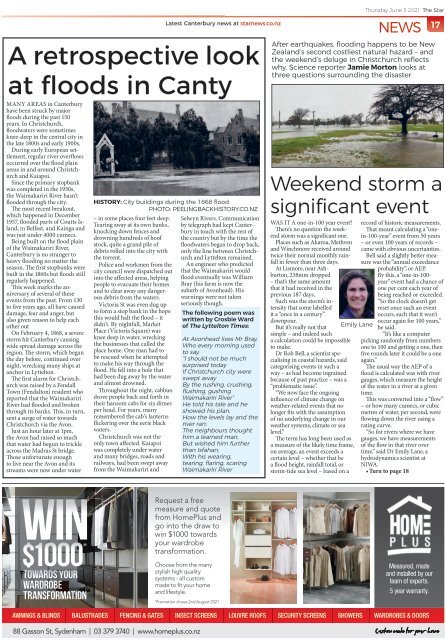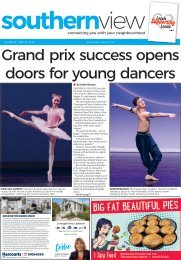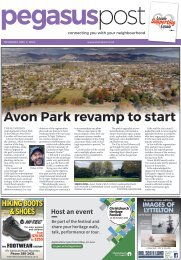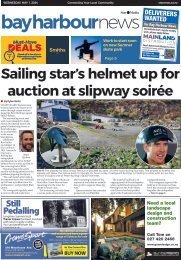The Star: June 03, 2021
Create successful ePaper yourself
Turn your PDF publications into a flip-book with our unique Google optimized e-Paper software.
Latest Canterbury news at starnews.co.nz<br />
A retrospective look<br />
at floods in Canty<br />
Thursday <strong>June</strong> 3 <strong>2021</strong> <strong>The</strong> <strong>Star</strong><br />
NEWS 17<br />
After earthquakes, flooding happens to be New<br />
Zealand’s second costliest natural hazard – and<br />
the weekend’s deluge in Christchurch reflects<br />
why. Science reporter Jamie Morton looks at<br />
three questions surrounding the disaster<br />
MANY AREAS in Canterbury<br />
have been struck by major<br />
floods during the past 150<br />
years. In Christchurch,<br />
floodwaters were sometimes<br />
knee-deep in the central city in<br />
the late 1800s and early 1900s.<br />
During early European settlement,<br />
regular river overflows<br />
occurred over the flood plain<br />
areas in and around Christchurch<br />
and Kaiapoi.<br />
Since the primary stopbank<br />
was completed in the 1930s,<br />
the Waimakariri River hasn’t<br />
flooded through the city.<br />
<strong>The</strong> most recent breakout,<br />
which happened in December<br />
1957, flooded parts of Coutts Island,<br />
in Belfast, and Kainga and<br />
was just under 4000 cumecs.<br />
Being built on the flood plain<br />
of the Waimakariri River,<br />
Canterbury is no stranger to<br />
heavy flooding no matter the<br />
season. <strong>The</strong> first stopbanks were<br />
built in the 1860s but floods still<br />
regularly happened.<br />
This week marks the anniversary<br />
of several of these<br />
events from the past. From 130<br />
to five years ago, all have caused<br />
damage, fear and anger, but<br />
also given reason to help each<br />
other out<br />
On February 4, 1868, a severe<br />
storm hit Canterbury causing<br />
wide spread damage across the<br />
region. <strong>The</strong> storm, which began<br />
the day before, continued over<br />
night, wrecking many ships at<br />
anchor in Lyttelton.<br />
<strong>The</strong> first alarm for Christchurch<br />
was raised by a Fendall<br />
Town (Fendalton) resident who<br />
reported that the Waimakariri<br />
River had flooded and broken<br />
through its banks. This, in turn,<br />
sent a surge of water towards<br />
Christchurch via the Avon.<br />
Just an hour later at 1pm,<br />
the Avon had raised so much<br />
that water had begun to trickle<br />
across the Madras St bridge.<br />
Those unfortunate enough<br />
to live near the Avon and its<br />
streams were now under water<br />
HISTORY: City buildings during the 1868 flood.<br />
PHOTO: PEELINGBACKHISTORY.CO.NZ<br />
– in some places four feet deep.<br />
Tearing away at its own banks,<br />
knocking down fences and<br />
drowning hundreds of hoof<br />
stock, quite a grand pile of<br />
debris rolled into the city with<br />
the torrent.<br />
Police and workmen from the<br />
city council were dispatched out<br />
into the affected areas, helping<br />
people to evacuate their homes<br />
and to clear away any dangerous<br />
debris from the waters.<br />
Victoria St was even dug up<br />
to form a stop bank in the hope<br />
this would halt the flood – it<br />
didn’t. By nightfall, Market<br />
Place (Victoria Square) was<br />
knee deep in water, wrecking<br />
the businesses that called the<br />
place home. One man had to<br />
be rescued when he attempted<br />
to make his way through the<br />
flood. He fell into a hole that<br />
had been dug away by the water<br />
and almost drowned.<br />
Throughout the night, cabbies<br />
drove people back and forth in<br />
their hansom cabs for six dimes<br />
per head. For years, many<br />
remembered the cab’s lanterns<br />
flickering over the eerie black<br />
waters.<br />
Christchurch was not the<br />
only town affected. Kaiapoi<br />
was completely under water<br />
and many bridges, roads and<br />
railways, had been swept away<br />
from the Waimakariri and<br />
Selwyn Rivers. Communication<br />
by telegraph had kept Canterbury<br />
in touch with the rest of<br />
the country but by the time the<br />
floodwaters began to drop back,<br />
only the line between Christchurch<br />
and Lyttelton remained.<br />
An engineer who predicted<br />
that the Waimakariri would<br />
flood eventually was William<br />
Bray (his farm is now the<br />
suburb of Avonhead). His<br />
warnings were not taken<br />
seriously though.<br />
<strong>The</strong> following poem was<br />
written by Crosbie Ward<br />
of <strong>The</strong> Lyttelton Times:<br />
At Avonhead lives Mr Bray,<br />
Who every morning used<br />
to say,<br />
“I should not be much<br />
surprised today<br />
If Christchurch city were<br />
swept away<br />
By the rushing, crushing,<br />
flushing, gushing<br />
Waimakariri River”<br />
He told his tale and he<br />
showed his plan,<br />
How the levels lay and the<br />
river ran;<br />
<strong>The</strong> neighbours thought<br />
him a learned man,<br />
But wished him further<br />
than Isfahan,<br />
With his wearing,<br />
tearing, flaring, scaring<br />
Waimakariri River<br />
Weekend storm a<br />
significant event<br />
WAS IT A one-in-100 year event?<br />
<strong>The</strong>re’s no question the weekend<br />
storm was a significant one.<br />
Places such as Akaroa, Methven<br />
and Winchmore received around<br />
twice their normal monthly rainfall<br />
in fewer than three days.<br />
At Lismore, near Ashburton,<br />
238mm dropped<br />
– that’s the same amount<br />
that it had received in the<br />
previous 187 days.<br />
Such was the storm’s intensity<br />
that some labelled<br />
it a “once in a century”<br />
downpour.<br />
But it’s really not that<br />
simple – and indeed such<br />
a calculation could be impossible<br />
to make.<br />
Dr Rob Bell, a scientist specialising<br />
in coastal hazards, said<br />
categorising events in such a<br />
way – as had become ingrained<br />
because of past practice – was a<br />
“problematic issue”.<br />
“We now face the ongoing<br />
influence of climate change on<br />
weather-related events that no<br />
longer fits with the assumption<br />
of no underlying change in our<br />
weather systems, climate or sea<br />
level.”<br />
<strong>The</strong> term has long been used as<br />
a measure of the likely time frame,<br />
on average, an event exceeds a<br />
certain level – whether that be<br />
a flood height, rainfall total, or<br />
storm-tide sea level – based on a<br />
Emily Lane<br />
record of historic measurements.<br />
That meant calculating a “onein-100-year”<br />
event from 50 years<br />
– or even 100 years of records –<br />
came with obvious uncertainties.<br />
Bell said a slightly better measure<br />
was the “annual exceedance<br />
probability”, or AEP.<br />
By this, a “one-in-100-<br />
year” event had a chance of<br />
one per cent each year of<br />
being reached or exceeded.<br />
“So the clock doesn’t get<br />
reset once such an event<br />
occurs, such that it won’t<br />
occur again for 100 years,”<br />
he said.<br />
“It’s like a computer<br />
picking randomly from numbers<br />
one to 100 and getting a one, then<br />
five rounds later it could be a one<br />
again.”<br />
<strong>The</strong> usual way the AEP of a<br />
flood is calculated was with river<br />
gauges, which measure the height<br />
of the water in a river at a given<br />
time.<br />
This was converted into a “flow”<br />
– or how many cumecs, or cubic<br />
metres of water, per second, were<br />
flowing down the river using a<br />
rating curve.<br />
“So for rivers where we have<br />
gauges, we have measurements<br />
of the flow in that river over<br />
time,” said Dr Emily Lane, a<br />
hydrodynamics scientist at<br />
NIWA.<br />
• Turn to page 18<br />
WIN<br />
$1000 *<br />
TOWARDS YOUR<br />
wardrobe<br />
TRANSFORMATION<br />
Request a free<br />
measure and quote<br />
from HomePlus and<br />
go into the draw to<br />
win $1000 towards<br />
your wardrobe<br />
transformation.<br />
Choose from the many<br />
stylish high quality<br />
systems - all custom<br />
made to fit your home<br />
and lifestyle.<br />
*<br />
Promotion closes 2nd August <strong>2021</strong><br />
Measured, made<br />
and installed by our<br />
team of experts.<br />
5 year warranty.<br />
AWNINGS & BLINDS BALUSTRADES FENCING & GATES INSECT SCREENS LOUVRE ROOFS SECURITY SCREENS SHOWERS WARDROBES & DOORS<br />
88 Gasson St, Sydenham | <strong>03</strong> 379 3740 | www.homeplus.co.nz


















